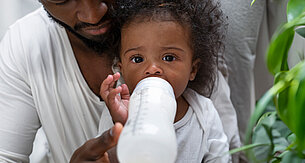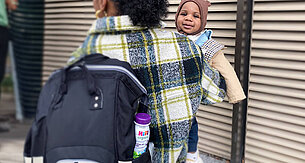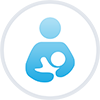Lactose intolerance in babies

Lactose is an important source of carbohydrates for babies found in all forms of milk, including breast milk, formula milk and animal milk. Unfortunately, sometimes babies develop what is called lactose intolerance – an inability to digest this magic milk sugar. This can cause a lot of discomfort, but symptoms can usually be resolved by removing lactose from baby’s diet.
What’s the difference between lactose intolerance and a milk allergy?
With an allergy, the body mistakes a protein – such as cows’ milk protein – for something harmful and has an immune response to it. Lactose is not a protein and so it is not possible to be allergic to lactose.
Instead, lactose intolerance is a side effect of not having any – or not having enough – lactase, the enzyme your body produces to break down lactose and use it to provide energy. The result is that the lactose goes undigested, causing uncomfortable symptoms.
What are the symptoms of lactose intolerance in babies?
The symptoms of lactose intolerance can vary, especially in babies, but you might notice the following:
- Diarrhoea/constipation
- Being unsettled
- Frequent crying
- Loose, watery stools (may be green/yellow in colour)
- Trapped wind
- Flatulence
- Noisy bowel sounds
- Vomiting
These symptoms might occur anywhere from within a few minutes to a few hours of having milk or milk products. Since the symptoms are so general, and can also be caused by other things, it can be quite hard to spot lactose intolerance in a young baby.
Types of lactose intolerance
There are four different types of lactose intolerance:
- Congenital lactose intolerance, where a baby is born without any of the lactase enzyme. This is rare. Symptoms tend to occur after the first milk feeds.
- Primary lactose intolerance, where a baby is born with the lactase enzyme, but the amount gets smaller over time and symptoms increase. The baby might be able to have small amounts of milk, but over time lactose-free baby formula alternatives may need to be used.
- Secondary lactose intolerance. This is a temporary condition where illness affects how well the body can make the lactase enzyme. Symptoms usually go away after 3 – 4 weeks.
- Developmental lactose intolerance. This can occur in babies born prematurely, whose gut lining is underdeveloped. Symptoms usually disappear once the baby’s digestive system matures
How is lactose intolerance diagnosed?
If you suspect your baby may have lactose intolerance, it's important to see your GP as soon as possible, to rule out anything else that might be causing the symptoms. Your GP may take a medical history, look at how well your baby has been growing and make a note of any symptoms you've noticed. They might also ask you to try giving your little one a lactose-free milk for babies and avoiding weaning foods that contain lactose for a trial period to see if this solves the problem. If it does, your GP may ask you to continue with this diet to stop the symptoms from coming back.
How is it treated and what lactose free formulas are available?
If your baby is diagnosed with lactose intolerance, you'll need to avoid lactose, both in milk and in foods. For very young babies, this will involve switching to a lactose-free formula milk for babies and weaning diet, and they may need additional calcium, magnesium and zinc to replace what they aren’t getting from milk.
For older babies, you may need to swap from a milk-free formula to a lactose-free milk (found in most supermarkets), and check ingredients labels on other foods carefully to make sure they don't contain lactose. Look for the word ‘milk’ in bold within the ingredients list. With primary lactose intolerance, toddlers can sometimes tolerate small amounts of foods with lactose, such as cheese and yoghurt. In this case, your GP or dietitian can advise you. The NHS Choices website has more information about lactose intolerance.
This can all sound a bit daunting, but there's a silver lining: removing the lactose usually resolves the symptoms, which leads to a healthier, happier baby. Happily, many supermarkets now have quite a good range of lactose-free products so it’s not as challenging as it used to be to eliminate lactose from your child’s diet.





